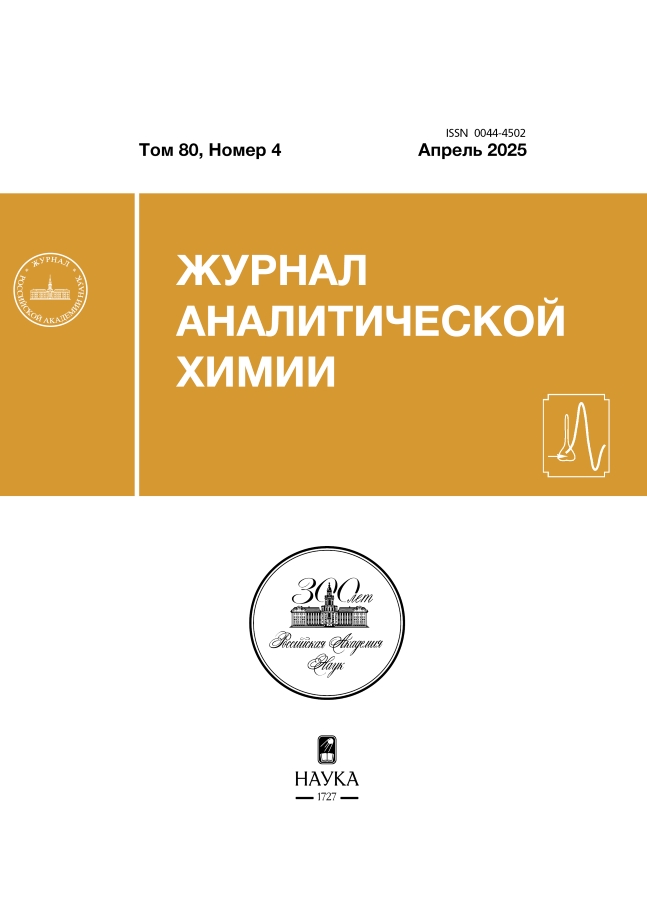Separation and concentration of biologically active compounds by capillary electrophoresis using modifiers based on imidazolium cation
- Authors: Ganieva A.S.1, Kartsova L.A.1
-
Affiliations:
- St. Petersburg State University
- Issue: Vol 80, No 4 (2025)
- Pages: 427-436
- Section: ORIGINAL ARTICLES
- Submitted: 05.06.2025
- URL: https://ruspoj.com/0044-4502/article/view/683049
- DOI: https://doi.org/10.31857/S0044450225040073
- EDN: https://elibrary.ru/aksfdl
- ID: 683049
Cite item
Abstract
A cationic covalent coating of quartz capillary walls based on imidazolium cation was synthesised; the reproducibility by electroosmotic flow (marker dimethylformamide) was 99 %. The conditions (concentration and pH of background electrolyte, nature and volume of organic additive) for their separation by capillary electrophoresis were optimised on model systems of phenyl- and indolecarboxylic acids (phenyl lactic, phenylanthanoic, phenyl butanoic, indole lactic, indolpropionic, indolacrylic hydroxymindal, homogentisic, homovanilinic, hydroxindoleacetic acids): 10 mM phosphate buffer solution with pH 4.2 with addition of 10 vol. % acetonitrile. The resolution factors of neighbouring pairs of analytes ranged from 1.7 to 18.9. The possibility of intracapillary concentration of phenyl- and indolecarboxylic acids using the synthesised coating was shown. Electrostacking allowed to concentrate the analytes 106–512 times and to lower the detection limits to 4–72 ng/ml.
Full Text
About the authors
A. Sh. Ganieva
St. Petersburg State University
Author for correspondence.
Email: st110520@student.spbu.ru
Russian Federation, Saint-Petersburg
L. A. Kartsova
St. Petersburg State University
Email: st110520@student.spbu.ru
Russian Federation, Saint-Petersburg
References
- Карцова Л.А., Макеева Д.В., Бессонова Е.А. Современное состояние метода капиллярного электрофореза // Журн. аналит. химии. 2020. Т. 75. № 12. С. 1497. (Kartsova L., Makeeva D., Bessonova E. Current status of capillary electrophoresis // J. Anal. Chem. 2020. V. 75. № 12. P. 1497.)
- Kravchenko A., Kolobova E., Kartsova L. Multifunction covalent coatings for separation of amino acids, biogenic amines, steroid hormones, and ketoprofen enantiomers by capillary electrophoresis and capillary electrochromatography // Sep. Sci. Plus. 2020. V. 3. № 4. P. 102.
- Yang M., Lv W., Chen Y., Wu X., Gao J., Xiao J. et al. Chiral-induced covalent organic framework as novel chiral stationary phase for chiral separation using open-tubular capillary electrochromatography // J. Chromatogr. A. 2024. V. 1736. № 465334.
- Li X., Ma Q., Zheng X., Chen Q., Sun X. Recent applications and chiral separation development based on stationary phases in open tubular capillary electrochromatography (2019–2022) // J. Pharm. Anal. 2023. V. 13. № 4. P. 323.
- Bai Q., Zhang C., Zhao Y., Wang C., Maihemuti M., Sun C. et al. Evaluation of chiral separation based on bovine serum albumin–conjugated carbon nanotubes as stationary phase in capillary electrochromatography // Electrophoresis. 2020. V. 41. № 13-14. P. 1253.
- Kowalski P., Olędzka I., Plenis A., Roszkowska A., Bączek T. Strengths and weaknesses of ionic liquids as efficiency enhancers in capillary electrophoresis // TrAC, Trends Anal. Chem. 2023. V. 132. Article 117031.
- Chankvetadze B., Scriba G.K.E. Cyclodextrins as chiral selectors in capillary electrophoresis: Recent trends in mechanistic studies // TrAC, Trends Anal. Chem. 2023. V. 160. № 22. Article 116987.
- Tang W., Lu Y., Row K.H., Baeck S.H., Zhang Y., Sun G. Novel bovine serum album and β-cyclodextrin-based mixed chiral stationary phase for the enantioseparation in capillary electrochromatography // Microchem. J. 2022. V. 121. Article 107763.
- Kartsova L., Makeeva D., Davankov V. Nano-sized polymer and polymer-coated particles in electrokinetic separations // TrAC, Trends Anal. Chem. 2019. V. 120. Article 115656.
- Yun X., Wang L., Wang J. Enantioseparation of six profenoid drugs by capillary electrophoresis with bovine serum albumin-modified gold nanoparticles as quasi- stationary phases // J. Chromatogr. B. 2024. V. 1243. Article 124228.
- Fu Y., Li Z., Hu C., Li Q., Chen Z. In-situ immobilization of covalent organic frameworks as stationary phase for capillary electrochromatography // J. Chromatogr. A. 2023. V. 1705. Article 464205.
- He N., Li Z., Hu C., Chen Z. In situ synthesis of a spherical covalent organic framework as a stationary phase for capillary electrochromatography // J. Pharm. Anal. 2022. V. 12. № 4. P. 610.
- Ding W., Ma Du Y., Chen C., Ma X. Metal organic framework ZIF-90 modified with lactobionic acid for use in improved open tubular capillary electrochromatographic enantioseparation of five basic drugs // Microchim. Acta. 2020. V. 187. Article 651.
- Petr J., Maier V. Analysis of microorganisms by capillary electrophoresis // TrAC, Trends Anal. Chem. 2012. V. 31. P. 9.
- Hsu Ch.-N., Tain Y.-L. developmental programming and reprogramming of hypertension and kidney disease: Impact of tryptophan metabolism // Int. J. Mol. Sci. 2020. V. 21. № 22. P. 8705.
- Yun Y., Zhang Q., Zhao W., Ma T., Fan H., Bai L. et al. Relationship between the tryptophan-kynurenine pathway and painful physical symptoms in patients with major depressive disorder // J. Psychosom. Res. 2022. V. 163. Article 111069.
- Kolobova E., Kartsova L., Kravchenko A., Bessonova E. Imidazolium ionic liquids as dynamic and covalent modifiers of electrophoretic systems for determination of catecholamines // Talanta. 2018. V. 188. P. 183.
- Бессонова Е.А., Карцова Л.А. Методы on-line концентрирования в капиллярном электрофорезе / Проблемы аналитической химии. Т. 18. Капиллярный электрофорез / Под ред. Л.А. Карцовой. М.: Наука, 2014. С. 76.
Supplementary files

















